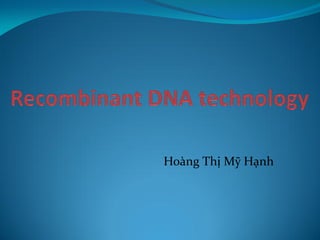Recombinant dna-1
•
2 gostaram•401 visualizações
Written by Dr Hoang Thi My Hanh VNU University of Science
Denunciar
Compartilhar
Denunciar
Compartilhar
Baixar para ler offline

Recomendados
Recomendados
Mais conteúdo relacionado
Mais procurados
Mais procurados (20)
Gene Editing: An Essential Tool For Plant Breeding

Gene Editing: An Essential Tool For Plant Breeding
Semelhante a Recombinant dna-1
Semelhante a Recombinant dna-1 (20)
Restriction Endonuclease: The Molecular Scissor of DNA - By RIKI NATH

Restriction Endonuclease: The Molecular Scissor of DNA - By RIKI NATH
Genetic Engineering by Kailash Sontakke Botany Sem-VI Unit-IV all

Genetic Engineering by Kailash Sontakke Botany Sem-VI Unit-IV all
Último
Último (20)
Biogenic Sulfur Gases as Biosignatures on Temperate Sub-Neptune Waterworlds

Biogenic Sulfur Gases as Biosignatures on Temperate Sub-Neptune Waterworlds
Human & Veterinary Respiratory Physilogy_DR.E.Muralinath_Associate Professor....

Human & Veterinary Respiratory Physilogy_DR.E.Muralinath_Associate Professor....
Call Girls Ahmedabad +917728919243 call me Independent Escort Service

Call Girls Ahmedabad +917728919243 call me Independent Escort Service
Module for Grade 9 for Asynchronous/Distance learning

Module for Grade 9 for Asynchronous/Distance learning
Justdial Call Girls In Indirapuram, Ghaziabad, 8800357707 Escorts Service

Justdial Call Girls In Indirapuram, Ghaziabad, 8800357707 Escorts Service
Locating and isolating a gene, FISH, GISH, Chromosome walking and jumping, te...

Locating and isolating a gene, FISH, GISH, Chromosome walking and jumping, te...
FAIRSpectra - Enabling the FAIRification of Spectroscopy and Spectrometry

FAIRSpectra - Enabling the FAIRification of Spectroscopy and Spectrometry
pumpkin fruit fly, water melon fruit fly, cucumber fruit fly

pumpkin fruit fly, water melon fruit fly, cucumber fruit fly
9999266834 Call Girls In Noida Sector 22 (Delhi) Call Girl Service

9999266834 Call Girls In Noida Sector 22 (Delhi) Call Girl Service
300003-World Science Day For Peace And Development.pptx

300003-World Science Day For Peace And Development.pptx
Recombinant dna-1
- 1. Hoàng Thị Mỹ Hạnh
- 2. Recombinant DNA Technology Recombinant DNA technology procedures by which DNA from different species can be isolated, cut and spliced together -- new "recombinant " molecules are then multiplied in quantity in populations of rapidly dividing cells (e.g. bacteria, yeast).
- 3. Application of Recombinant DNA Human gene therapy: recombinant human insulin, recombinant human growth factor, recombinant hepatitis B vaccine… Engineered crop plants: golden rice (β-carotene), herbicide resistant crops, insect resistant crops…
- 5. Recombinant DNA Tool Vector Enzyme used in molecular biology Host cells
- 6. Restriction enzyme Recognize and cut at DNA specific sequence DNA ligase Join compatible ends of DNA fragment. Use ATP Alkaline phosphatase Remove phosphate group from strand of DNA Polynucleotide kinase Add phosphate group to a DNA strand in the 5’ to 3’ direction DNA polymeraseI DNA synthesize Exonuclease III Digest nucleotide from a DNA strand in the 3’ to 5’ direction RNAse Nuclease digest RNA, not DNA Taq DNA polymerase Heat-stable DNA polymerase isolated from thermostable microbe.
- 7. Restriction enzymes are primarily found in bacteria and are given abbreviations based on genus and species of the bacteria. One of the first restriction enzymes to be isolated was from EcoRI EcoRI is so named because it was isolated from Escherichia coli strain called RY13. Restriction Enzymes
- 8. Classify restriction enzymes Type I enzymes are complex, multisubunit, combination restriction-and- modification enzymes that cut DNA at random far from their recognition sequences. Type II enzymes cut DNA at defined positions close to or within their recognition sequences. Type III enzymes are also large combination restriction-and-modification enzymes. They cleave outside of their recognition sequences and require two such sequences in opposite orientations within the same DNA molecule to accomplish cleavage; they rarely give complete digests. Type IV enzymes recognize modified, typically methylated DNA and are exemplified by the McrBC and Mrr systems of E. coli.
- 9. Restriction Enzymes Bacteria have learned to "restrict" the possibility of attack from foreign DNA by means of "restriction enzymes”. Cut up “foreign” DNA that invades the cell. Type II and III restriction enzymes cleave DNA chains at selected sites. Enzymes may recognize 4, 6 or more bases in selecting sites for cleavage. An enzyme that recognizes a 6-base sequence is called a "six-base cutter”.
- 10. Type II restriction enzyme EcoRI – Escherichia coli strain R, 1st enzyme BamHI – Bacillus amyloliquefaciens strain H, 1st enzyme DpnI – Diplococcus pneumoniae, 1st enzyme HindIII – Haemophilus influenzae, strain D, 3rd enzyme BglII – Bacillus globigii, 2nd enzyme PstI – Providencia stuartii 164, 1st enzyme Sau3AI – Staphylococcus aureus strain 3A, 1st enzyme KpnI – Klebsiella pneumoniae, 1st enzyme
- 11. Basics of type II Restriction Enzymes No ATP requirement. Recognition sites in double stranded DNA have a 2-fold axis of symmetry – a “palindrome”. Cleavage can leave staggered or "sticky" ends or can produce "blunt” ends.
- 13. Results of Type II Digestion Enzymes with staggered cuts complementary ends HindIII - leaves 5´ overhangs (“sticky”) 5’ --AAGCTT-- 3’ 5’ --A AGCTT--3’ 3’ --TTCGAA-- 5’ 3’ –TTCGA A--5’ KpnI leaves 3´ overhangs (“sticky”) 5’--GGTACC-- 3’ 5’ –GGTAC C-- 3’ 3’--CCATGG-- 5’ 3’ –C CATGG-- 5’
- 14. Results of Type II Digestion Enzymes that cut at same position on both strands leave “blunt” ends SmaI Isochizomer XmarI 5’ --CCCGGG-- 3’ 5’ --CCC GGG-- 3’ 3’ --GGGCCC-- 5’ 3’ --GGG CCC-- 5’
- 18. Restriction Endonucleases Cleave DNA at specific DNA sequences
- 19. Converting sticky ends to blunt ends Filling in Trimming back
- 20. Converting blunt end to sticky end by using linker
- 21. Converting blunt end to sticky end by using linker
- 22. DNA Ligase in Action!
- 23. Electrophoresis Gel electrophoresis is a method for separation and analysis of macromolecules (DNA, RNA and proteins) and their fragments, based on their size and charge.
- 24. Gel: Agarose or Acrylamide Dye Nucleic acid stain: EtBr Marker Running time
- 28. Electrophoretic mobility of form of plasmid DNA Circular DNA Linear DNA Supercoil DNA Hypersupercoil DNA
- 30. Uncut plasmid DNA can be in five forms Nicked Circular Linear covalently close Supercoil Hyper supercoil